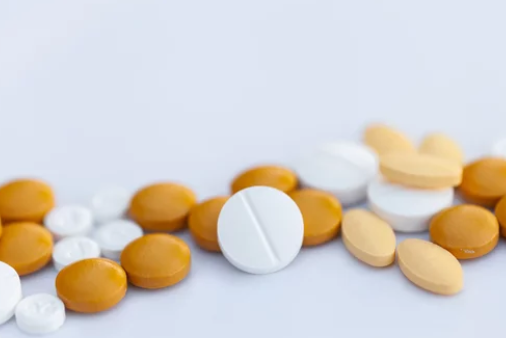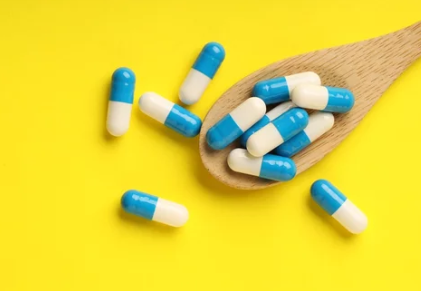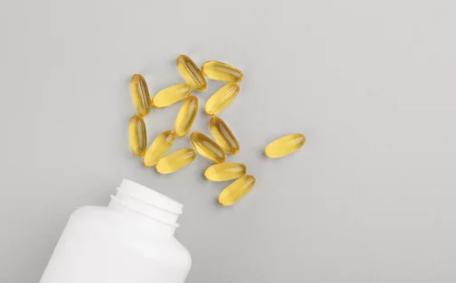Pills are an essential part of human health and the supplement industry. They control dosage accurately, improve treatment safety, and support large-scale production. Over time, pills have developed into different types. Each is designed to meet different medical needs.
Fourteen different types of pills in the pharma industry
Pills could be separated into various types based on ingredients or functions.
Four Dosage forms
Dosage forms are the physical forms in which medicines are produced and given to patients. They describe how the drug is shaped and delivered into the body. It depends on the drug’s properties, how it works in the body, and the patient’s needs.
Tablets

Tablets are solid pills. They are made by compressing powdered ingredients into a hard shape. They are the most widely used type of pill because tablets are low-cost and easy to store. Tablets can be plain or designed with coatings to improve taste. The coating could also protect the drug from stomach acid or make swallowing easier. They are common in both prescription and over-the-counter medicines.
Capsules

Capsules are pills that enclose medicine inside a shell. They hold powders, granules, or little pellets. They have many advantages. Besides easy swallowing, the smooth shell masks bitter tastes or odors. Capsules have a body and a cap. They are usually made of gelatin or plant-based material. The shell dissolves in the stomach or intestine to release the drug.
Softgels

Softgels are integrated capsules with a soft and flexible outer shell. They contain liquid or semi-liquid medicine. Sofegels are often used for oils, vitamins, or herbal extracts. Softgels have many shapes, such as rounds and ovals. They are also easy to swallow, making them popular in the supplement industry.
Coated pills

Coated pills have an outer layer that protects the medicine or improves its appearance. Sugar coatings, film coatings, or enteric coatings can be used. Some coatings make the pill easier to swallow. Others protect the drug from stomach acid so it can reach the intestine to be released. This type is common for medicines that may irritate the stomach.
Four different pills based on the release mechanism
Immediate-release pills
Immediate-release pills are designed to dissolve quickly in the stomach and release the drug at once. They are useful when a fast effect is needed, such as in painkillers or fever reducers. However, the drug may wear off quickly, so patients often need to take multiple doses a day.
Extended-release pills
Extended-release pills release the drug slowly over time. This helps maintain a steady level of medicine in the body and reduces the number of daily doses. They are often used for chronic conditions such as high blood pressure or diabetes.
Delayed-release pills
Delayed-release pills are designed to release the drug later, usually after passing through the stomach. A common example is enteric-coated pills, which dissolve in the intestine to avoid stomach irritation. It also protects drugs that are sensitive to acid.
Controlled-release pills
Controlled-release pills deliver the drug in a precise way over an extended period. They not only release the drug slowly but also control the pattern of release. For example, they may release a small amount at first. Then it produces a steady flow for many hours, or even in pulses at set times. This needs more advanced technology in the pill design.
Three pill types by how they are taken
According to patient needs, there are different medicines to be consumed in various ways.
Oral pills
Oral pills are the most common type. Patients swallow them with water, and the pill dissolves in the stomach or intestine. It is easy, safe, and convenient. This is why most medicines are made in oral form for pain, fever, infections, or chronic conditions.
Chewable pills
These pills are made to be chewed before swallowing. They are easier for children and people who cannot swallow whole tablets. Vitamins, antacids, and some allergy medicines are often made in chewable form.
Effervescent pills
Effervescent pills dissolve in water before drinking. They release gas, which makes the solution fizzy. This method helps the drug absorb faster. It is also gentle on the stomach, not making it sensitive. Common effervescent pills include vitamin C tablets and some pain relievers.
Three pill types for patient needs
Pills for children
These medicines often come in smaller doses and easier forms. Chewable tablets, flavored tablets, or orally disintegrating pills are common examples. Because many children cannot swallow standard tablets. These forms make treatment easier and reduce resistance when giving medicine to young kids.
Medicines for elderly people
Older adults may face difficulty swallowing or may need several medications each day. Pills for this group are often made in easy-to-swallow shapes or orally disintegrating forms. Some also use extended-release designs to reduce the number of daily doses.
For patients with sensitive stomachs
Certain patients need pills that are gentle on the stomach. Enteric-coated tablets or delayed-release capsules are designed to avoid stomach acid and dissolve in the intestine. This reduces irritation and protects drugs that would otherwise break down in stomach acid.
How do pills work?
After a person swallows a pill, it dissolves in the stomach or intestine and releases the active drug. The drug is then absorbed into the bloodstream. It carries the drug to the organs or tissues where it is needed, such as lowering blood pressure. Some pills act quickly, while others are designed to release the drug slowly over time. Eventually, the body processes the drug in the liver and removes it through the kidneys or digestive system.
How to choose the pill type if you want to make?
If you want to make medicines, there are some considerations you need to know.
Treatment purpose
The treatment goal strongly influences pill type selection. Medicines for quick relief, such as emergency drugs, may require fast-acting forms like orally disintegrating pills. For long-term therapies that require stable blood levels, extended-release or controlled-release pills are more suitable.
API Properties
The physical and chemical characteristics of API play a critical role. You need to consider their solubility, stability, heat sensitivity, and dose size. These elements determine what pill forms should be. Poorly soluble or fat-soluble APIs may be better suited for softgels, while acid-sensitive ingredients often need enteric coatings. High-dose APIs may be difficult to compress into small tablets. They are always made into capsules or divided into doses.
Customer preference
Pill size, taste, mouthfeel, and dosing frequency affect how patients take their medicine. Market research and formulation design should consider patient preferences. If your customers are children, flavored chewables are better. If your clients are vegetarians, veggie capsules are preferred.
Pill manufacturing equipment
Different pill types require different machines and skills. You need matching ones to produce the pills you need. Since there is a wide selection of equipment, you’d better choose the best one based on your production volume and budget. Take a capsule filling machine for example. If you run a workshop, a manual capsule filler is a good choice. Though this model features the lowest efficiency, it is the cheapest.
Regulatory requirements
Every country has its own rules for pill production. It includes how pills are made, what ingredients can be used, and what data must be submitted before a drug can be sold. For example, a coating material allowed in Europe may not be accepted in the U.S. Sometimes, a capsule made with animal-based gelatin may face limits in certain markets. Thus, you need to have a clear understanding of related compliance requirements in your market.
The end
From tablets and capsules to softgels and coated forms, each pill type features different purposes and working methods. For manufacturers, a clear selection is important for the pharma business. Pill types remain one of the most key ways to deliver medicine in healthcare today.